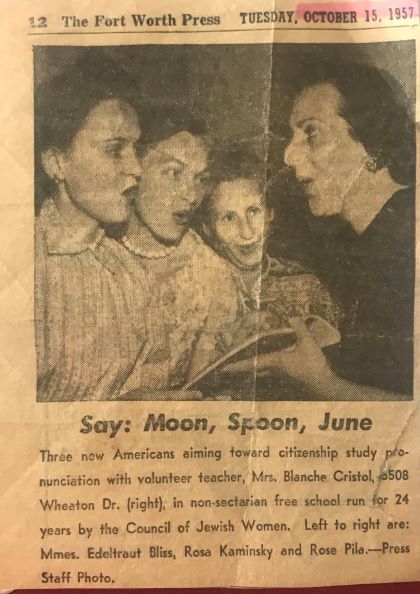Part 2: A 30-Year Top Seller at Neiman Marcus
Last week I told the story of my mom and how her family’s world was ripped apart by World War II. Life in war-torn Germany was already exceptionally tough for Mom and her family in the town where they lived. Shortages of food, rationing of other goods, and limited means to earn an income were daily challenges for most.
Chaos ensued as the Russian army closed in on the Nazi regime from the east and the Allies did the same from the west. The Nazi-controlled government forced Mom’s family and the townspeople on a train to nowhere, leaving all of their life’s possessions behind.
After seven days, all the train’s passengers were forced off hundreds of miles from their home. In an instant, my mom’s family of five children and her mother became starving, homeless, and desperate refugees of war.
The plight of my mom and her family is told in part one of this story called a “Mother’s Day Story.”
Moving to the United States
My mom and dad married in 1955. The wedding was spartan, yet filled with joy. Within two months, they were on a ship headed to America. Mom had already lived a life filled with hard work and missed out on the experiences and education of high school. But now, she was headed for an adventure in a new land with the American man she loved. Living in America had only been a dream, but it was quickly becoming a reality. The excitement of living in a country of riches and untouched by the ravages of war seemed too good to be true.
Their final destination would be Fort Worth, Texas. Dad’s parents moved there from a tiny town in Arkansas hugging the Mississippi River in 1947. His family left their hometown to escape malaria that plagued the region where they lived. Grandpa was a lineman for the telephone company and Grandma the proprietor of a small beauty salon.
Unanticipated Struggles
The steamy relentless heat of a Texas summer hit Mom like nothing she’d ever experienced. Mom’s surprise pregnancy made the heat seem even more excruciating. This was the late ’50s in Texas and refrigerated air was the exception in most homes and buildings.
Even worse than the heat was her isolation. Because she didn’t know English, she was unable to communicate with others around her. It made her more homesick with each passing day. Mom admits that her first two years in the U.S. were the hardest time of her life, even worse than living in a war-ravaged landscape.
It would be five years until my parents could find a way for Mom and my sister to return to visit her family.
Adjusting to Life in Texas
Life began to normalize for Mom as she discovered a local program teaching English to German immigrants. She then felt comfortable enough to attend evening courses in English grammar and writing. In 1962, the family grew to four with the addition of me. Both Mom and Dad shared an almost obsessive passion for hard work. You could see it in the way our small home stood out in the neighborhood of track homes.

For some people who grow up poor, there can be a constant memory of difficult times that goes so far as to influence their work ethic. Dad saw his parents struggles living through the depression and the lean times of World War II. Mom’s family lost almost everything during the war. Both of my parents were driven to provide a better life for my sister and I.
Dad worked in the defense industry for most of his career. The job provided a decent income, but my parents dreamed of a larger home. They always spent less than they made, and with every paycheck they purchased U.S. Government Series E bonds for their kids’ education. Whatever money was leftover was set aside in a savings account. But they still wanted more. 30 years passed before they paid off their first home that cost $10,000 in the early 60s. In 1983 after scrimping and saving, my parents bought their dream house. They still live there today.
A New Career for Mom
In 1971, one of Mom’s German friends encouraged her to apply to Neiman Marcus. Unlike working in retail today, it was very challenging to get a position at Neiman Marcus. Like most companies today, Neiman Marcus preferred referrals from their top performers to add new employees. Neiman Marcus offered Mom a temporary position during their Christmas season that started in October and ran through the end of December.
Investing for Success
As the years passed in my career, I often reflected about how companies prepare their staff to sell their product or service. My experience had mostly been the “you’ll figure it out” approach to corporate education. It struck me how unusual Mom’s experience was compared to mine and what I knew of most company training programs.
Even though Mom was just a temporary employee, she was required to attend the same two-week new-hire training class as full-time staff. In the early ’70s, Neiman Marcus was a local family-owned retail business at the time with two stores in Dallas and one in Fort Worth. Their merchandise was luxurious and unique. But it was their relentless obsession with superior service that defined its brand.
Marcus introduced many of the innovations for which Neiman-Marcus became known, creating a national award for service in fashion and hosting art exhibitions in the store itself, as well as weekly fashion shows and an annual Fortnight event highlighting a different foreign country for two weeks each year. He established the Neiman-Marcus Christmas Catalogue, which became famous for extravagant “His and Hers” gifts such as airplanes and camels. Marcus prided himself on his staff’s ability to provide service and value for each client, often citing his father’s dictum, “There is never a good sale for Neiman Marcus unless it’s a good buy for the customer.”
Reference: https://en.wikipedia.org/wiki/Stanley_Marcus
Can you imagine a retail company in today’s world investing in an education program for every new employee? Retail is a cut-throat business but if you don’t invest in your people, how can management expect superior results. The lack of proper education for sales staff is pervasive across most companies and industries.
Mom’s temporary sales job in the accessories department in the Fort Worth store transitioned into a full-time position working three days per week. Her full-time role allowed her to move from accessories to the galleria department where beautiful and stylish dresses and ladies suits were sold.
The two weeks of new-hire education that each employee at Neiman Marcus attended covered a variety of topics that ran the gamut, from learning the different types of clothing fabrics, how to dress to Neiman’s standards, withholding judgment of shoppers, and how to approach every person who came into the store.
For example, they were told never to say, “May I help you?” to a customer. It is easily interpreted as “May I sell you something?” and provides an easy way out for the customer to simply say, “No, thank you.” Instead, they were taught to say, “Is there anything I can show you?” or “What can I help you find?”
A Manual Customer Relation Management System
One of the most important things Neiman Marcus trained its employees on was managing their clientele book. Each salesperson was required to capture their customer’s name and contact information during the sale. Notes were made on what they bought, clothing preferences and other likes and dislikes. Over time, personal information like their birth dates, anniversary dates, kids’ names, spouse’s name and more were collected.
Salespeople were required to send handwritten letters to their clients for a variety of reasons. Thanking clients for their business, notifying them of upcoming sales or events, and calling them when unique items became available were just a few of the reasons to contact customers.
The Mr. and Mrs. Account
And then there was the Mr. and Mrs. account. Certain men would shop in the store for their wife and apparently their mistress, too. Salespeople were expected to quietly notate in their clientele books when one of these men sent gifts to an address besides their own. “Whatever you do, don’t send the sales item to the wrong address,” was the message that came from every new-hire training class. Mom witnessed a couple of mistakes where the mistress’ gift was sent to the man’s wife by mistake. I would like to have been a fly on the wall to see how that got explained away!
Thirty Years of Sales Success
While Mom worked just three days a week for her first 15 years, she was always recognized among the top 25 salespeople in the store out of a sales staff of over 100. For the 15 years that followed, she would increase to working four days a week. In 1995, she was the top salesperson in the store eclipsing $1 million in sales for the year, (equivalent to about $1.7 million in today’s money). This was all the more noteworthy because she beat out people working five days a week. Mom was always the number one seller in her department and always in the top ten salespeople in the store during her last 15 years.
Mom’s secret to success was quite simple.
- Know the merchandise
- Learn what your customers like
- Have an opinion
- Be friendly and humble
- Work your clientele book relentlessly
- Hustle, hustle, hustle
Customers who frequented Neiman Marcus during Mom’s tenure expected a different experience than they’d get at other stores. Distinctive merchandise was a given, as well as superior and honest service. Customers didn’t have to ask Mom if she liked the dress on them; she would tell them. She called every customer to let them know when outfits that she knew they’d like came in. Customers became so confident and comfortable with her selections, they’d simply ask her to send the outfits to their homes.
Even when automated letters could be generated, Mom never stopped sending handwritten thank-you letters. While most of Neiman’s sellers planned their lunch between 11:00 a.m. and 1:30 p.m., mom always ate at 10:30 a.m., or not at all, to ensure she was on the floor during prime selling hours.
Every year she would hit her new goal, and every year it was raised to what seemed like an impossibly high figure. Her sales target was always much higher than those working five days a week.
Conclusion
I never truly appreciated Mom’s amazing sales achievements until my career inadvertently turned toward sales. While listening to Mom answer my questions for this story, one thing was clear about her success: she learned at a very young age what hard work meant. As a teenager, her income helped support her mom and siblings in post-World War II Germany. Failure was not an option. Perhaps her childhood experiences drove her to not fail her manager and store. I never heard her make an excuse why she couldn’t get something done; instead, she worked tirelessly at her craft, as well as being a rockstar mother too.
That’s my mom’s story. I hope you enjoyed it and perhaps found a little inspiration too.

